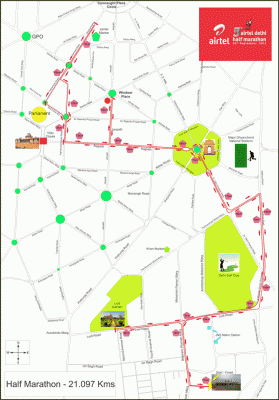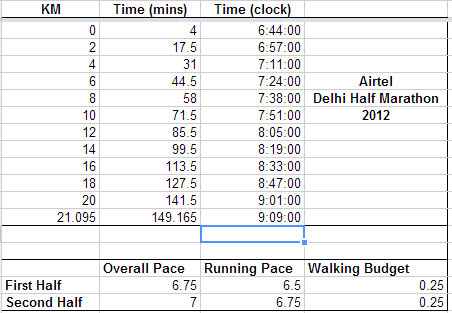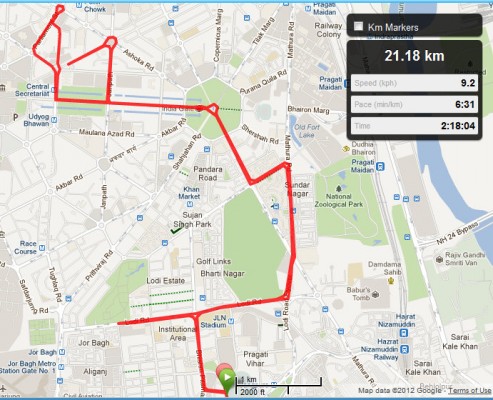I am the official pacer for the 2:30 bus (or pacing group, i.e. people who are running with the objective of finishing the run in under 2:30 hours) at the 2012 Airtel Delhi Half Marathon. This is the first time that Procam, the organizers of the event, have introduced pacers at the Airtel Delhi Half Marathon after having successfully tried the same at this years Mumbai Marathon (where I was the pacer for 5:30 finish). There would be pacers for the 2:00 hours, 2:30 hours and 3:00 hours finish time goals. There will be two pacers for each target finish time, so in all, 6 pacers. You can see the list of all pacers on the event website.
My BIB#: 6746 | Starting group: B | Target finish time: 2:30
What’s the Pacer’s job?
Whether you’re new to the 21.1KM half marathon distance or a marathon veteran, you can join the Airtel Delhi Half Marathon pace team for help with running a steady pace and achieving your race-day time goal. Each pace team leader is a seasoned and reliable marathoner who will offer coaching and support throughout the race.
Pace team leaders will run the half marathon at an even pace, meaning that every KM will be run in approximately the same amount of time at a constant pace. The pacers will target to finish the half marathon no more than two minutes faster than the goal time, based on gun time. Which means if the race started at 6:40 am and you (or the pacer) crossed the starting line at 6:44 am (due to the rush and people in front), for a 2:30 finish target time, the pacer should be at the finish line by 9:10 am (and not 9:14 am), which means the pacer will have to cover the required 21.1KM distance in 2:26 hours and not 2:30.
The Pacing Strategy
For a 2:30 finish at the Airtel Delhi Half Marathon, we would be targeting to run at a constant pace throughout the race. Throughout the run, we will be stopping at all the water points, take a couple of sips of water from the 200 ml bottles which will be available at the water points, and walk for about 30-40 seconds while we drink water, and then restart with our running. We can expect to see water points at approximately every two kilometer, which means we will be taking a little break every 14 mins or so.
How fast would we be running during the race? We have 2:30 hours to finish it, which means, we should be covering every kilometer at a pace of 150 minutes / 21.1 KM = 7.1 minutes / KM. But we know that we would be walking for about 10-15 times during the run, and the plan is also to walk up any inclines which we are bound to encounter on the route. So, we have to budget time for that also, and so, we have to run a bit faster as a result. So, our actually running pace would finally be in the region of 6:30 mins/KM (for the first half of the half marathon) to 6:40 mins / KM (for the second half of the half marathon). That should be good to make is reach our goal within the target time of 2 hours 30 minutes.
Pacing Chart
2012 Route Map
There have been very minor changes to the route which was used for the 2011 Airtel Delhi Half Marathon. On the right is the 2012 route (click to open in larger size). If you would look in great detail, you will see that they have removed a small section after the Ashoka Road roundabout, and extended the section on the Parliament street.
2011 Route Map
This is the actual GPS route map from my Garmin watch captured during the 2011 Airtel Delhi Half Marathon. Click on it to view more details, as well as to check out the elevation data for the route.
How To Find Me On Race Day?
That’s a bit tough, isn’t it, when there are thousands around you! But the organizers have made it a bit easy. I will be running carrying a flag on my back which lists my pacing time, i.e. 2:30 prominently on it (see the image on the top-right of this article to see how that flag looks like). I will be wearing a T-shirt with the words “Tanvir 2:30 Pace Team” prominently written on the back. I have been assigned a ‘B’ starting section (i.e. runners who finished their last half marathon between 2 and 3 hours).
I would expect that the set of people who would want to finish in 2:30 would come from the ‘B’ group (those who ran last time between 2:30 and 3:00 hours, but many also from the ‘C’ group (most first timers). So, my plan is to start from the very end of the ‘B’ group and only start running when some of the runners at the start of the ‘C’ group have already overtaken me. This will at least help me in catching the folks who probably need me the most, i.e. first time runners from the ‘C’ group.
So, for people in the ‘B’ group ahead of me, I would say just go ahead and start running at your own pace, and when I catch up with you (if I do at all) then we can start running together. And to the ‘C’ group people, I would say that try to be in the front of the ‘C’ group, otherwise there is a high chance you will have to chase me down a bit, or even miss me, since I cannot wait for too much time before starting my run. That said, I would not be running fast, so people from behind should not have much trouble catching up. This should be fair to both ‘B’ group and ‘C’ group people.
Other Do’s And Don’ts
Check them out on the other pacing article I wrote earlier for the Mumbai Marathon, I am sure that would be very useful and I do not want to repeat the same content in this article again. There are quite a few useful tips for runners related to hydration, food, etc.


Leave a Reply